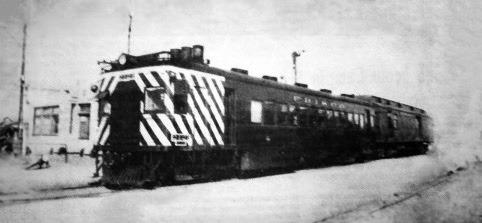Older generations of Marshall Countians may fondly rememberthepopular,Frisco Railroad “Dinky” train. Anybody who remembers riding the “Dinky,” they are likely at least 75 years old.
So, for those readers who were born after about 1950, or for those who are new to Marshall County and might be asking, “What was the Dinky”, this story is for you. Read on to find out why some folks still mention the Dinky when reminiscing about the “goodolddays,”andwhymost have grins from ear to ear when someone asks, “do you remember the time we rode the Dinky?”
In 1900, the St. Louis-San Francisco Railway, more commonly called the “Frisco” Railroad,beganlayingamain line from Sapulpa, Indian Territory, south through Madill, Helen, Woodville and on to Denison, Texas. In 1904, the Frisco added a branch line from Ardmore, through Madill, Aylesworth, Durant and Boswell, finally ending in Hugo.
That branch line then extended from Hugo through Fort Towson and Idabel over to Hope, Ark. By 1904, ten passenger trains passed through Madill every day. Passenger trains were stopping in Madill about every one to two hours during daylight hours. In 1910, the Frisco Railroad then added what locals lovingly called the “Dinky” train to its fleet to service low volume branch lines.
The “Dinky” train was a series 2100, self-propelled rail motorcar manufactured by the Electro-Motive Corporation. It was powered by a gas-electric engine and a few weregasmechanicalengines. In 1910, the Frisco ordered 10 of these motorcars, but then added seven more in 1913.
By 1914, there were twenty motorcarsnumbered21002019, and they included nine baggage-coach combinations, and one baggage, mail coach unit. By 1931, the Frisco operated a fleet of twenty-three gas electric motor cars, five gas engine motor cars, four trail coaches and six mail baggage units.
The “Dinky” was a onepiece motorcar with a passenger compartment and either a baggage compartment or a mail compartment. Some units also pulled an extra passenger coach or a mail/ baggage car.
Each unit was 72 feet long with a 400-horsepower engine. The “Dinky” trains operated on Frisco Branch linesinnumerouslocationsin Oklahoma, Missouri, Arkansas, KansasandTexas.Other railroads also had versions of the“Dinky”runningtheirlow volume branch lines.
Interestingly, the moniker, “Dinky,” appears to be a Marshall County area name for the train because the Frisco Railroad officially called the train the “Doodlebug” because of its “insectlike” appearance. The name Doodlebug was also applied to the trains because they operated at slow speeds, and when observed running down the track, folks would say, “hey, look at that thing doodling down the tracks.”
The “Dinky” passed through Madill and Aylesworth twice a day. The train left Ardmore early each morning, passing through Madill, then Aylesworth and then on to Hugo.
The trip took about four hours. Then, the “Dinky” would return from Hugo, arriving back in Ardmore late in the afternoon for a round tripofroughlyeightandahalf hours. In Hugo, a passenger could then board a second “Dinky” and ride all the way to Hope, Ark.
In addition to carrying passengers, the “Dinky” also transported mail and cargo from Ardmore to Madill and Aylesworth and back to Ardmore. In fact, the “Dinky” was the primary way incoming mail was transferred to Madill and Aylesworth and outgoing mail was transported back to Ardmore.
In the late 1930s, when Lake Texoma was being constructed, and Aylesworth was abandoned, the “Dinky” began running through Kingstonbeforeheadingonto Durant. It was during these days that the “Dinky” was in its prime.
The train was a popular way for folks to get from Madill or Kingston to Durant for a day of shopping or business. They could ride down in the morning and return late in the afternoon.
By the 1950s, the popularity of the “Dinky” began to wane as busses and automobiles becamemoreconvenient and popular.
The “Dinky” was also plagued with arrival time issues. Some days, it could run an hour or more late going or coming, and this uncertainty made the train less popular as time passed.
The last “Dinky/Doodlebug” train in the Frisco fleet was the Number 2128, that ran the Ardmore to Hugo branch line. That final Frisco run of that line of trains occurred November 7, 1953, when the “Dinky” left Hugo for a return trip to Ardmore. Only a few of those Electro-Motive Corporation “Dinky/ Doodlebug” motorcars remain in existence today in museums around the country.
Many miss the golden age of passenger trains. In many ways, those trains built this country.In1910,thebestway to get from town to town was by a train.
For rural areas, the mainstay of travel was the “Dinky/ Doodlebug”. Old Timers that rode the “Dinky”, in the days before television, cell phones, and the internet, have fond memories of the joy they experienced while “doodling” down the tracks.
They remember riding with the windows down and wind in blowing their hair, while watching the countryside “doodle”bytheirwindow. They remember the excitement of traveling to cities and townsfaroff,wonderingwhat adventures awaited them on the other end of the line. They remember those simple times. Times filled with fun and excitement. Carefree days with friends and family.
The train may have been dinky in size, but it was huge in importance to the early days of Madill, Aylesworth and Helen/Kingston. It may have been small for a train, but it was big in the hearts of the people of Marshall County. Joy can come in small packages. Sometimes, it can even be “Dinky”.

